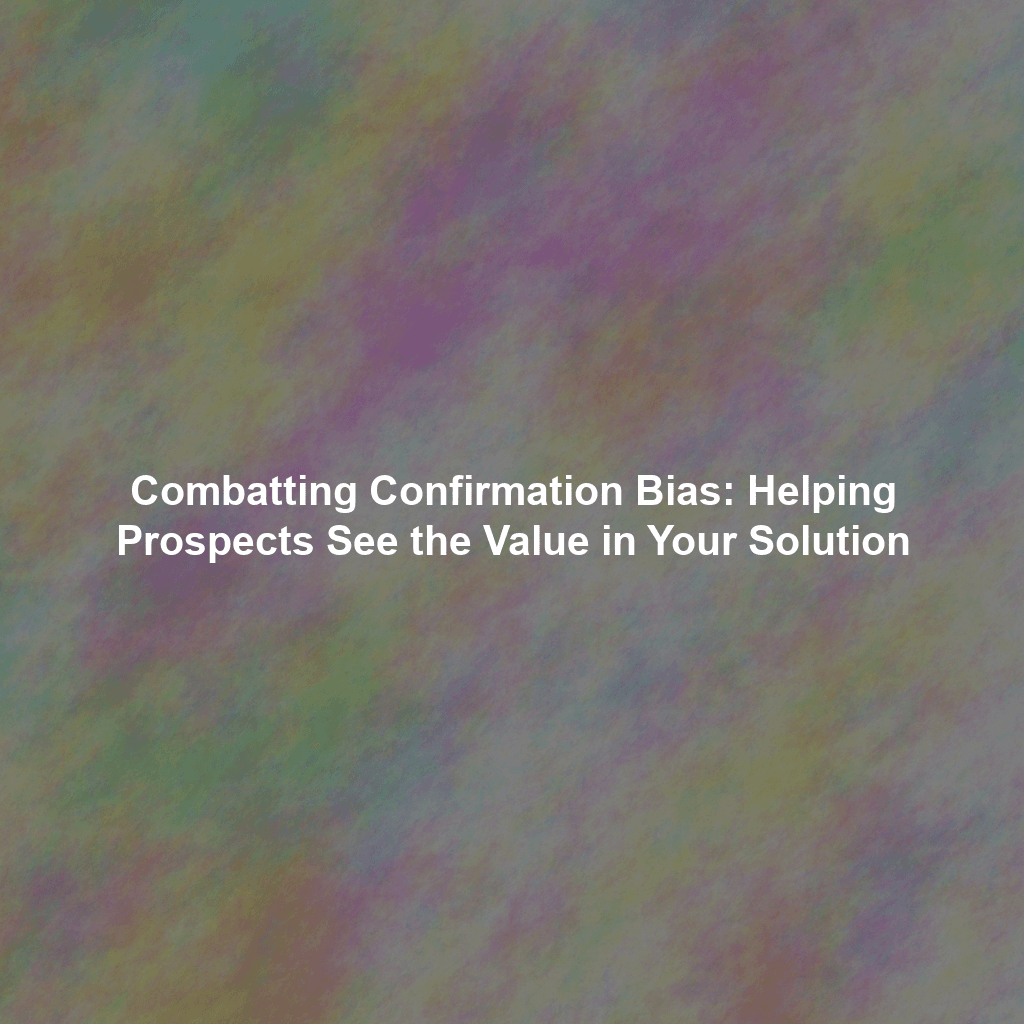As sales professionals, we strive to present compelling solutions that address our prospects’ needs. But sometimes, even the most persuasive pitch falls flat. Why? Often, the culprit is a sneaky cognitive bias called confirmation bias. This inherent human tendency to favor information that confirms existing beliefs can create significant roadblocks in the sales process. This article will explore how confirmation bias manifests in sales and provide actionable strategies to overcome it, ultimately helping your prospects see the true value of your offering.
Understanding Confirmation Bias and Its Impact on Sales
Confirmation bias is the tendency to search for, interpret, favor, and recall information in a way that confirms or supports one’s prior beliefs or values. In essence, we selectively pay attention to information that aligns with what we already think is true and disregard or downplay contradictory evidence. Imagine a prospect who believes their current CRM is “good enough.” They might readily accept positive feedback about their CRM while dismissing any negative feedback or suggestions that a different solution might be better.
How Confirmation Bias Hinders the Sales Process
Confirmation bias can sabotage sales in several ways:
- Resistance to New Information: Prospects may be unwilling to consider alternative solutions or new perspectives. They’re already convinced they have the best approach.
- Dismissal of Compelling Evidence: Even with solid data, ROI calculations, or case studies, prospects may find ways to rationalize or dismiss the information if it contradicts their pre-existing beliefs.
- Focus on Flaws, Ignoring Benefits: Prospects are more likely to scrutinize perceived weaknesses in your solution while overlooking its strengths and benefits.
- Delayed Decision-Making: The prospect may seek out only information that validates their current state, delaying or preventing a purchase decision.
Strategies for Overcoming Confirmation Bias in Sales
While you can’t eliminate confirmation bias entirely, you can mitigate its negative effects by employing strategic techniques throughout the sales process. Here’s how:
Uncover Preconceived Notions Through Active Listening
Before presenting your solution, invest time in understanding your prospect’s existing beliefs and assumptions. Ask open-ended questions that encourage them to articulate their perspectives:
- “What are your biggest challenges with your current system/process?”
- “What are your goals for improving [area of business]?”
- “What have you already tried to address this problem?”
- “What are your expectations for a solution like ours?”
Pay close attention to their language, tone, and the types of information they emphasize. This will provide valuable clues about their existing beliefs and potential biases.
Present Unbiased Information and Counter-Arguments
Avoid simply presenting your solution as the “best” option. Instead, frame it as a potential solution that addresses their specific needs and challenges. Acknowledge any potential drawbacks or limitations of your offering and contrast them with the benefits. Transparently acknowledge limitations your prospect already holds as true, it builds trust and allows you to then address them.
For example, instead of saying, “Our software is the only one you need,” try: “While our software doesn’t have [feature X], it excels at [features A, B, and C], which are crucial for achieving your goals of [specific business outcomes]. We’ve found that feature X is often handled effectively through [alternative solution].”
Provide data-backed comparisons to competing solutions, highlighting the objective strengths and weaknesses of each. Using third-party data, like industry reports and customer reviews, can lend credibility and reduce the perception of bias.
Leverage Social Proof and Testimonials Strategically
Social proof can be a powerful tool, but it’s important to use it thoughtfully. Select testimonials and case studies that address potential concerns or counter common misconceptions. Instead of solely highlighting success stories, consider featuring examples where customers initially had doubts but ultimately achieved positive results.
For instance, share a case study where a company initially believed their in-house solution was sufficient but eventually realized the benefits of your offering after experiencing measurable improvements in efficiency or revenue.
Ask Questions That Challenge Assumptions
Guide prospects to question their own assumptions by asking probing questions that encourage critical thinking. For example:
- “What would happen if you continued with your current approach?”
- “What are the potential costs of not addressing this problem?”
- “What evidence would convince you that a different solution is worth considering?”
These questions can help prospects recognize the limitations of their current thinking and open them up to new possibilities.
Frame Information to Highlight Gains and Avoid Losses
People are generally more motivated to avoid losses than to acquire equivalent gains. Frame your solution in terms of the potential losses they’ll avoid by switching or the gains they’ll miss out on if they stick with the status quo.
For example, instead of saying, “Our software can increase your sales by 10%,” try: “By not using our software, you’re potentially losing out on a 10% increase in sales, which could translate to [specific financial impact].”
Present Information in Multiple Formats
People process information differently. Some are visual learners, while others prefer to absorb information through auditory or kinesthetic methods. Present your solution using a variety of formats, such as presentations, demos, written reports, and interactive tools, to cater to diverse learning styles. This will increase the likelihood that your message resonates with your prospect and overcomes their pre-existing biases.
Conclusion: Guiding Prospects to Informed Decisions
Confirmation bias is a powerful force that can significantly impact the sales process. By understanding how it works and implementing the strategies outlined above, you can help prospects overcome their preconceived notions and make informed decisions based on facts and data. The goal isn’t to manipulate prospects, but to guide them towards a solution that truly addresses their needs and helps them achieve their goals. When you prioritize honesty, transparency, and objective information, you build trust and establish long-term relationships that benefit both you and your customers.
 Skip to content
Skip to content

